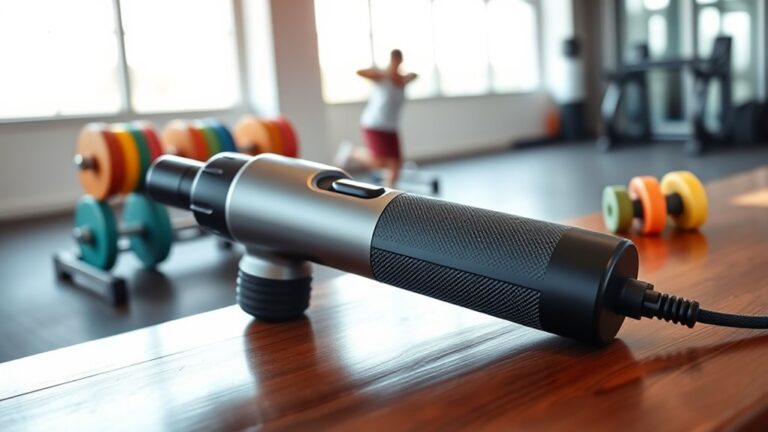How to Train With Asthma Safely at the Gym

To train safely with asthma at the gym, first identify your triggers and consult with your healthcare provider. Warm up gradually to prepare your lungs, and choose asthma-friendly exercises like swimming or cycling. Keep your rescue inhaler accessible at all times and monitor your breathing during workouts. Stay well-hydrated and prioritize a balanced diet to support performance. Pay attention to your body’s signals to make necessary adjustments. Continue exploring strategies to optimize your gym experience effectively.
Understand Your Asthma Triggers

When exercising with asthma, it’s vital to identify your asthma triggers to manage your condition effectively. Asthma triggers can vary from person to person and often include environmental factors such as pollen, dust mites, mold, smoke, and cold air. Knowing what specifically triggers your asthma can help you take proactive steps to minimize exposure during workouts.
For instance, if pollen is a trigger for you, consider exercising indoors during high pollen seasons. Similarly, if cold air exacerbates your symptoms, opt for a warm, humid environment. It’s also important to be aware of air quality; pollution can greatly impact your breathing.
Consult With Your Healthcare Provider
Before starting any exercise program, it’s essential to consult with your healthcare provider, especially if you have asthma. Your provider can evaluate your current asthma management plan and determine how it aligns with your fitness goals. They may assess your lung function, review your medications, and suggest any necessary adjustments to guarantee exercise safety.
Discussing your exercise intentions with your healthcare provider allows them to identify potential risks and develop strategies to minimize them. This may include recommendations on pre-exercise medication or specific warm-up routines tailored to your needs.
Your provider can also educate you on recognizing early signs of an asthma attack during workouts, enabling you to take prompt action if needed. Ultimately, this proactive approach to asthma management will enhance your confidence and safety while exercising, allowing you to enjoy the fitness benefits without compromising your health.
Choose the Right Warm-Up Routine

Choosing the right warm-up routine is essential for managing asthma symptoms during exercise. A gradual warm-up helps prepare your lungs and muscles, while specific breathing techniques can improve oxygen flow. Aim for a warm-up duration of at least 10 to 15 minutes to effectively reduce the risk of asthma-related issues during your workout.
Importance of Gradual Warm-Up
A gradual warm-up is essential for individuals with asthma, as it helps prepare the respiratory system for increased physical activity. You should start with light cardiovascular exercises, such as brisk walking or cycling, for about 5 to 10 minutes. This elevates your heart rate gradually and promotes better airflow. Incorporating dynamic stretching into your routine is also vital; it not only improves flexibility but also facilitates the warm-up process. Focus on movements that engage major muscle groups, like arm circles and leg swings, ensuring that your body is fully prepared for more intense exercise. By following this approach, you can minimize the risk of asthma symptoms and enhance your overall workout experience, making your gym sessions safer and more effective.
Breathing Techniques to Use
As you prepare for your workout, incorporating specific breathing techniques can greatly enhance your warm-up routine, especially for those with asthma. Diaphragmatic breathing, often referred to as “abdominal breathing,” encourages deeper inhalation and helps maximize lung capacity. To practice this, focus on inhaling through your nose, allowing your diaphragm to expand, and then exhaling through your mouth.
Additionally, pursed lip breathing can be beneficial. This technique involves inhaling through your nose and exhaling slowly through pursed lips, which helps maintain open airways and regulate your breathing pattern. Integrating these techniques into your warm-up can stabilize your respiratory system, reduce anxiety, and prepare your body for more intense physical activity, ensuring a safer workout experience.
Duration of Warm-Up Sessions
Finding the right duration for your warm-up sessions is essential for optimizing your workouts, particularly when managing asthma. Aim for a warm-up duration of 10 to 15 minutes, gradually increasing both your heart rate and respiratory rate. Start with light aerobic activities, like walking or cycling, to prepare your body without triggering asthma symptoms.
Monitor your warm-up intensity; it should be low to moderate, allowing your body to adjust gradually. Incorporating dynamic stretches can also enhance flexibility while keeping the intensity manageable. Always listen to your body—if you feel any discomfort or shortness of breath, modify the duration or intensity as needed. This tailored approach helps maximize performance while minimizing asthma-related risks during exercise.
Select Asthma-Friendly Exercises

When selecting exercises that accommodate asthma, it’s essential to focus on activities that minimize the risk of triggering symptoms. Here are some asthma-friendly exercises you might consider:
- Yoga: The yoga benefits include improved flexibility and controlled breathing techniques, which can help manage asthma symptoms effectively.
- Swimming: Swimming options are excellent due to the warm, humid air in pools, which can be less irritating to your airways compared to dry environments.
- Walking: A low-impact activity that allows you to control your pace and intensity, reducing the likelihood of asthma triggers.
- Cycling: Whether indoors or outdoors, cycling can be a manageable way to enhance cardiovascular fitness while keeping your breathing in check.
Monitor Your Breathing During Workouts
Monitoring your breathing during workouts is essential for managing asthma effectively, particularly since physical exertion can sometimes trigger symptoms. By being aware of your breathing patterns, you can optimize your oxygen intake and reduce the risk of an asthma attack.
| Breathing Pattern | Impact on Oxygen Intake | Recommended Action |
|---|---|---|
| Deep, rhythmic | Maximizes oxygen | Maintain during low-intensity |
| Shallow, rapid | Reduces oxygen | Slow down, focus on breathing |
| Irregular | Increases anxiety | Pause, practice controlled breaths |
Pay attention to how your body feels as you exercise. If you notice changes in your breathing patterns, it may be time to adjust your intensity or take a moment to focus on your breath. Consistently monitoring your breathing can help you stay in control and enjoy your workouts safely.
Keep Your Rescue Inhaler Handy

Having your rescue inhaler easily accessible during workouts is essential for managing asthma symptoms effectively. You should know when to use it, as prompt action can prevent a potential asthma attack. Always keep it within reach to guarantee you can respond quickly if needed.
Importance of Accessibility
Although asthma can be effectively managed, it remains essential to keep your rescue inhaler readily accessible during workouts. Having it close at hand guarantees you can respond quickly if symptoms arise, allowing you to continue benefiting from your gym routine. Here are four key points to remember:
- Accessibility: Store your inhaler in a place where you can easily reach it during exercises.
- Awareness: Inform gym staff and workout partners about your condition and where your inhaler is located.
- Adaptive Equipment: Use adaptive equipment if necessary to minimize stress on your respiratory system.
- Gym Modifications: Choose gym modifications that suit your needs, guaranteeing a safe and effective workout environment.
Being prepared can make a significant difference in managing your asthma while staying active.
Know When to Use
Knowing when to use your rescue inhaler is vital for managing asthma effectively during workouts. Always monitor your asthma symptoms, such as wheezing, coughing, or shortness of breath. If you experience these signs, don’t hesitate to use your inhaler. Ideally, you should take your rescue inhaler 15-30 minutes before starting your workout, especially if you know your triggers or plan to engage in strenuous activities. It’s essential to keep your inhaler handy at all times; this guarantees immediate access should symptoms arise. Remember, proper inhaler usage—correct technique and dosage—can greatly improve your response during an asthma episode. Keep track of your symptoms and adjust your inhaler usage accordingly to maintain peak performance and safety while training.
Stay Hydrated and Maintain Proper Nutrition
When you’re managing asthma, staying hydrated and maintaining proper nutrition are essential for optimizing your gym performance. Proper hydration and nutrition can help prevent asthma symptoms during exercise and enhance your overall physical capability. Here are some hydration tips and nutrition strategies to keep in mind:
- Drink Water Regularly: Aim for at least 8-10 cups of water daily, adjusting based on your activity level and environment.
- Electrolyte Balance: Think about electrolyte-rich drinks if you’re exercising intensely or for extended periods to replenish lost minerals.
- Balanced Meals: Prioritize whole foods like fruits, vegetables, lean proteins, and whole grains to fuel your workouts and support lung health.
- Pre-Workout Snacks: Consume a light snack containing carbohydrates and protein about 30-60 minutes before exercising to maintain energy levels.
Listen to Your Body and Adjust Accordingly

Listening to your body is essential for managing asthma during workouts. Your body sends signals indicating how you’re responding to physical activity. Pay attention to symptoms like shortness of breath, wheezing, or chest tightness. These body signals can help you determine when to push harder or when to scale back.
If you notice any discomfort, make immediate workout adjustments. This could mean reducing the intensity, taking breaks, or even stopping altogether. It’s important to have a plan in place, such as knowing your inhaler’s location and using it as needed.
Consider keeping a log of your symptoms and workouts to identify patterns. This information can be advantageous for you and your healthcare provider in tailoring your exercise regimen. Ultimately, being attuned to your body will enhance your ability to train safely and effectively while managing asthma. Prioritize your health, and don’t hesitate to make necessary changes.
Frequently Asked Questions
Can I Use a Gym’S Air Conditioning to Help With My Asthma?
Yes, you can use a gym’s air conditioning to help manage your asthma. Air conditioning can improve air quality by filtering out allergens and pollutants, which is essential for asthma sufferers. Additionally, it helps with humidity control, reducing the likelihood of mold and dust mites that can trigger symptoms. However, it’s important to guarantee the system is well-maintained to avoid circulating irritants. Always monitor how you feel in the environment and adjust accordingly.
Should I Avoid Exercising Outdoors if I Have Asthma?
Did you know that nearly 30% of people with asthma report exercise-induced symptoms? If you have asthma, you might want to contemplate indoor exercise, especially during extreme weather conditions. Cold air or high pollen levels can exacerbate your symptoms. By avoiding outdoor workouts in unfavorable weather, you can minimize triggers and maintain your fitness safely. Always listen to your body and consult a healthcare professional for tailored advice regarding your exercise routine.
How Can I Find a Gym With Asthma-Friendly Conditions?
To find a gym with asthma-friendly conditions, start by researching facilities that boast asthma-friendly features, such as good ventilation systems and air filtration. Look for gyms that maintain consistent temperature and humidity levels to minimize triggers. When exploring gym membership options, consider asking staff about their policies on member health concerns. It’s essential to visit during peak hours to assess air quality and overall environment before committing to a membership.
Are There Specific Exercises to Avoid With Asthma?
When considering exercises to avoid with asthma, it’s essential to steer clear of high-intensity workouts that can trigger symptoms. Activities that involve sudden bursts of exertion may lead to breathing difficulties. Instead, focus on gradual, steady-paced exercises. Incorporating proper breathing techniques can help manage your condition effectively. Always listen to your body, and if you experience any discomfort, it’s wise to modify your routine or consult a healthcare professional for personalized guidance.
Can Asthma Medication Affect My Workout Performance?
Imagine a bird soaring through the sky, but sometimes it struggles against the wind. That’s how asthma can feel during your workouts. Asthma medication types, like bronchodilators, can indeed impact your performance. They might enhance your ability to exercise by opening airways, allowing for better oxygen flow. However, be mindful of workout intensity effects; overexertion can still trigger symptoms. Always consult your doctor to guarantee your medication supports your fitness journey safely.





